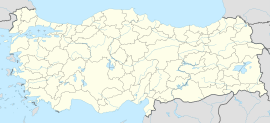Çadırkaya (Armenian: Բագառիճ, romanized: Bagarich) is a municipality (belde) in the Tercan District, Erzincan Province, Turkey.[1] It had a population of 2,013 in 2021.[2] Bagayarich (also spelled Bagayarič, Bagarich or Bagarinch) was an ancient locality in the northwestern part of Armenia in the district of Daranali (or Daranałi[k]). In ancient times, it housed the cult centre of the divinity Mihr (Mithra i.e. Mithras), the god of fire.[3][4]
Çadırkaya | |
|---|---|
| Coordinates: 39°50′31″N 40°13′30″E / 39.842°N 40.225°E | |
| Country | Turkey |
| Province | Erzincan |
| District | Tercan |
| Population (2021) | 2,013 |
| Time zone | UTC+3 (TRT) |
The neighborhoods of the municipality are Camii Kebir, Gözeler and Yeni.[1] It is the birthplace of Soghomon Tehlirian, a famous Armenian revolutionary and assassin of Talaat Pasha, one of the architects of the Armenian genocide.[5]
On the eve of World War I, before the Armenian genocide, the Armenian Patriarchate of Constantinople indicated that the town's population consisted of 1060 Armenians (in 182 houses), 750 Turks and 125 Zazas. It also harboured a medieval cathedral, a church, an Armenian school with 70 students as well as the ruins of a pagan temple dedicated to Mihr.[6] Statistics published by A-Do, compiled using data from the secretary of the Armenian church in Erzurum from around 1910, record 150 Armenian and 150 Muslim households within the settlement;[7] Teotig notes 182 Armenian families there.[8]
Name
editThe name of Bagayarich is attested in Greek by the ancient geographer and historian Strabo (died c. 24 AD) as *Bagaris and Basgoidariza, and by Ptolemy (died c. 170 AD), likewise in Greek, as *Bagarizaka.[3] The modern Turkish name is Pekeriç, and its new official name of Çadırkaya means "tent-rock".[9]: 242
Geography
editBagayarich is located near the northeastern corner of the Pekeriç plain.[9]: 242 This plain is separated from the Vican plain downstream on the Tuzla Su by a series of low hills.[9]: 242 Bagayarich itself is located at the base of a large conical rock which historically was the site of the town's fortress.[9]: 242, 250 The village consists of two distinct "lobes".[9]: 250
In ancient times, the locality of Bagayarich was situated on the primary road passing through northern Armenia that linked the town of Sebastaea (present-day Sivas) in the Roman Empire with Ecbatana (present-day Hamadan) in Media through Satala, Bagayarich, Karin (present-day Erzurum) and Artaxata (Artashat).[3]
History
editThe locality was known for being the site of the important temple of Mihr (i.e. Mithra, Mithras), that is, one of the eight main pagan shrines of pre-Christian Armenia. It was traditionally held to have been built by King Tigranes the Great (r. 95-56 BC).[3] The site first appears in Armenian historiography in late antique works. Within this context, according to Agathangelos, the temple of Mihr at Bagayarich was destroyed by Gregory the Illuminator.[10] The modern historian Robert H. Hewsen explains that the entire surrounding district of Daranali may have been part of the domain of the aforementioned Mihr temple, as, after it was destroyed during the conversion of Armenia to Christianity, the district of Daranali was turned into the property of the Armenian church.[3]
Bagayarich was historically the capital of the district of Derzene.[9]: 242 It has since been superseded by the town of Tercan, which perhaps took place in the early Ottoman period.[9]: 242
By the 20th century, Bagayarich was composed of two adjoining villages by the name of Verin ("upper") and Nerkin ("lower") Bagayarich, which respectively consisted of 80 and 130 homes.[3] Half of these homes were inhabited by Armenians and the other half by local Muslims. The two villages of Verin and Nerkin Bagayarich together formed the larger village in the caza ("district") of Derjan. At the time, the remains of what may have been the temple as well as an old castle could still be viewed at Bagayarich.[3][11]
Present status
editThe site's main focus in the present day is a conical hill. A simple radio tower is located at the peak of the site including some remnants of rough stone-and-mortar masonry dating back to the 19th or 20th century.[11]
References
edit- ^ a b "Türkiye Mülki İdare Bölümleri Envanteri". T.C. İçişleri Bakanlığı (in Turkish). Retrieved 19 December 2022.
- ^ "Address-based population registration system (ADNKS) results dated 31 December 2021" (XLS) (in Turkish). TÜİK. Retrieved 30 January 2023.
- ^ a b c d e f g Hewsen 1988, p. 408.
- ^ La Porta 2018.
- ^ Derogy, Jacques (1990). Resistance and Revenge: The Armenian Assassination of the Turkish Leaders Responsible for the 1915 massacres and deportations. New Brunswick, NJ: Transaction Publishers. p. 65. ISBN 9780887383380.
- ^ Kévorkian, Raymond H.; Paboudjian, Paul B., eds. (1992). Les Arméniens dans l'Empire ottoman: à la veille du génocide. Paris: Éd. d'Art et d'Histoire, ARHIS. p. 438. ISBN 978-2-906755-09-3.
- ^ Ա-Դօ (1912). Վանի, Բիթլիսի եւ Էրզրումի վիլայէթները: ուսումնասիրութեան մի փորձ այդ երկրի աշխարհագրական, վիճակագրական, իրաւական եւ տնտեսական դրութեան (in Armenian). Tparan Kultura. p. 187.
- ^ Tʻēodik (1985). Գողգոթա հայ հոգեւորականութեան եւ իր հոտին անղ−ետալի 1915 տարիին (in Armenian). Պուբլիշեդ բյ Ստ. Վարտան Պրեսս. p. 201.
- ^ a b c d e f g Sinclair, T.A. (1989). Eastern Turkey: An Architectural & Archaeological Survey, Volume II. Pindar Press. ISBN 0-907132-33-2. Retrieved 4 September 2022.
- ^ Canepa 2018, pp. 200–201.
- ^ a b Canepa 2018, p. 201.
Sources
edit- Canepa, Matthew P. (2018). The Iranian Expanse: Transforming Royal Identity through Architecture, Landscape, and the Built Environment, 550 BCE–642 CE. University of California Press. ISBN 978-0520964365.
- Hewsen, R. H. (1988). "BAGAYAṞIČ". In Yarshater, Ehsan (ed.). Encyclopædia Iranica, Volume III/4: Bačča(-ye) Saqqā–Bahai Faith III. London and New York: Routledge & Kegan Paul. p. 408. ISBN 978-0-71009-116-1.
- La Porta, Sergio (2018). "Zoroastrianism, Armenian". In Nicholson, Oliver (ed.). The Oxford Dictionary of Late Antiquity. Oxford: Oxford University Press. ISBN 978-0-19-866277-8.
